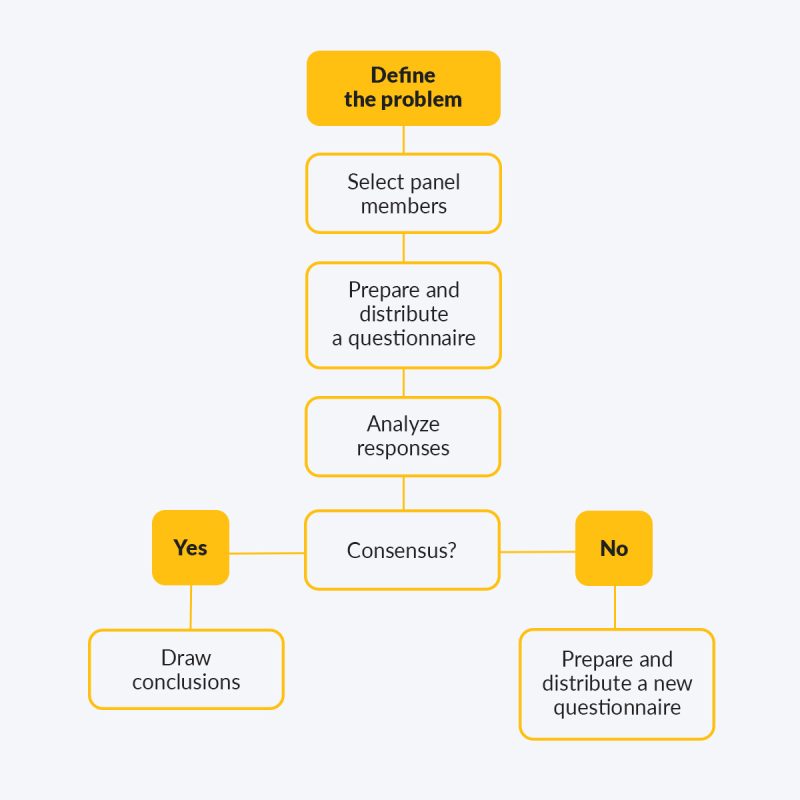Colloquially speaking, the Delphi technique is based on the popular saying “two heads are better than one”. It refers to the ancient city of Delphi, where the priestess Pythia from the temple of Apollo predicted the future. Do you know how to use it when creating your company’s strategy? Let’s find out!
The Delphi technique – table of contents:
- What is the Delphi technique?
- The Delphi technique in strategic management
- How to use the Delphi technique?
- The pros and cons of the Delphi technique
- An example of the Delphi technique
- Summary
What is the Delphi technique?
It is a research technique that is carried out in the form of a panel, consisting of a group of specialists in a specific field (usually it should be 10-18 people). Its purpose is to obtain information and opinions on a phenomenon likely to occur in the future.
The experts’ observations are collected by the moderator through questions (using a questionnaire). The received answers are then summarized in a final report. The process is repeated until there is consistent feedback by all group members.

The Delphi technique in strategic management
Forecasting possible events, economic crises, trends or growth opportunities is highly important in business management. However, quantitative analysis of available data doesn’t always provide comprehensive information.
Especially in the case of innovative ideas and completely new products, which can’t provide historical data to be compared with the current situation. Then, all you have left is qualitative research, which includes the Delphi method.
How to use the Delphi technique?
The individual stages of the research can be outlined as follows:
Defining the problem
Define what issue you want to address, be specific and clear.
Selecting panel members
This is an important step, and preparing it well will ensure that the entire process goes smoothly. For starters, choose the experts you would like to work with. The group should be diverse to stay objective and have access to different perspectives.
Depending on the topic of the research, they could be university lecturers, businessmen with years of experience, or even people just taking their first steps in the chosen field. Combining knowledge, practice and a fresh perspective can provide you with interesting results.
Next, decide who will be the facilitator of the process. Such a person should be familiar with the topic to understand the participants’ way of thinking, and at the same time ought to be impartial and neutral. Prepare a tool to collect the participants’ opinions. This can be a survey questionnaire with relevant questions.
Preparing and distributing a questionnaire
Conduct a survey among panel members, collect their replies.
Analyzing responses
Combine and contrast the collected information. Find out whether the presented opinions are consistent with each other. This is unlikely to happen in the first round. Create a report summarizing the results, which you will give to panel members for review along with another survey questionnaire(the questions are supposed to cover the same topic, although you can refine them). Experts will be able to review the report and express their opinions on the other participants’ views anonymously.
Reaching a consensus
The survey and analysis process should continue until the experts achieve a general sense of consensus.
Drawing conclusions
Once you have reached an agreement, analyze the obtained results and prepare an action plan.

The pros and cons of the Delphi technique
Pros
- The survey is anonymous, which encourages respondents to share their opinions freely.
- There is a lower risk of conflicts due to the facilitator who controls the entire process and gives time and opportunity to adjust opinions.
- Experts are involved in the whole process and can help implement the selected solutions.
- The method allows you to obtain objective results.
- You can get several options to solve the problem.
- Using this research method doesn’t require a lot of money and special tools – the most important thing is the time needed to gather final ideas.
Cons
- If the participants’ opinions differ significantly, the whole process can take much longer.
- There is little opportunity for discussion and exchange of views with each other.
- The facilitator must have strong interpersonal skills to oversee the process and the analytical skills needed to prepare a complete report.
An example of the Delphi technique
The Delphi technique can be used in many areas, also in business, for example, to develop key success factors (KSF) in the ecommerce industry.
Defining the problem
Ecommerce is a rapidly growing industry that makes international transactions possible. It is expected that by 2040, 95% of shopping transactions will be made online. For this reason, it makes sense to invest in this area, while keeping in mind the growing competition. Selecting KSF will help you decide what to focus on when developing your management strategy. Your research problems could be as follows:
- What is the current state of the ecommerce industry and is it possible to improve i t?
- What activities have the best chance of success in the industry over 5-10 years?
- What solutions are workable, given the political and economic conditions?
Selecting panel members
Choose experts and the facilitator qualified to participate in the process. Prepare the survey questionnaire that will help you identify the mentioned factors, select them and give them weights using a Likert scale (from 1 to 5, with 1 indicating no/low impact of the factor and 5 indicating high/very high impact).
Preparing and distributing a questionnaire
Choose key success factors (KSF) for the ecommerce industry.
Analyzing responses
Put the survey results together. Verify whether the presented key success factors are relevant to the research. Remove irrelevant factors or those that were mentioned least often. Prepare a summary report.
Collecting information and analyzing responses again
Provide a report to participants and conduct another round of surveys to adjust opinions.
Reaching a consensus
The process should be repeated until key success factors emerge from the responses, along with their weights.
Drawing conclusions
Prepare a summary report and an action plan for an e-commerce entity.
Summary
The method presented in the article is based on people’s subjective opinions and beliefs. Despite the reduction of group influence through anonymous and individual responses, there is still a risk of projecting other people’s judgments.
It is worth bearing this in mind when using this technique to look for strategic solutions, and also conduct other types of analysis (especially quantitative) to get a complete picture of the problem under study.
Read also: All about business process mapping. Can it be used in ecommerce?
If you like our content, join our busy bees community on Facebook, Twitter, LinkedIn, Instagram, YouTube, Pinterest, TikTok.
Author: Andy Nichols
A problem solver with 5 different degrees and endless reserves of motivation. This makes him a perfect Business Owner & Manager. When searching for employees and partners, openness and curiosity of the world are qualities he values the most.


















